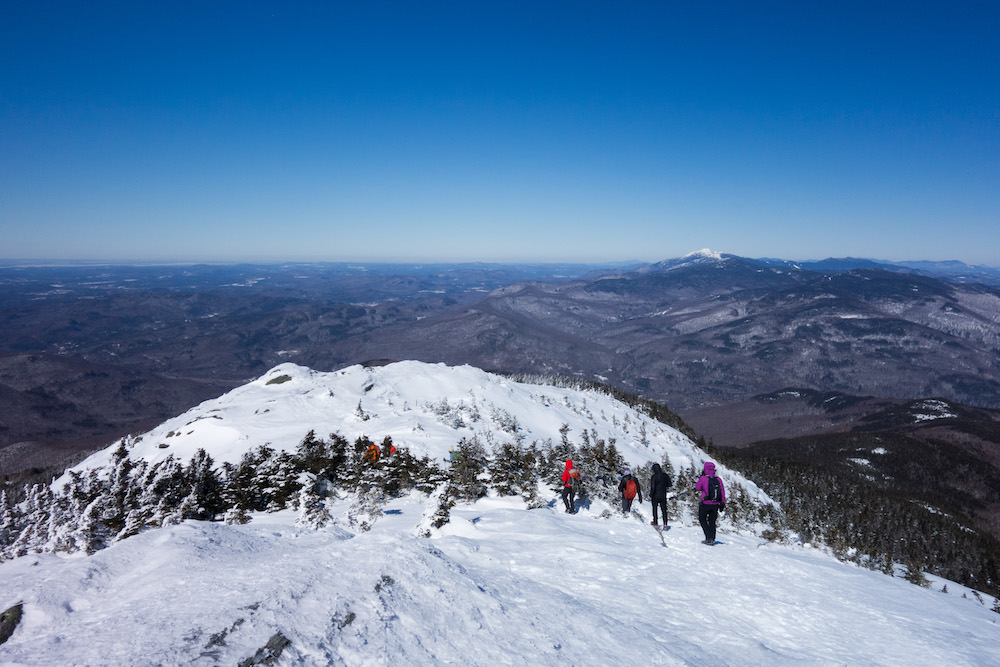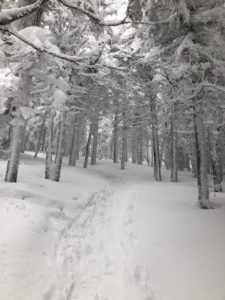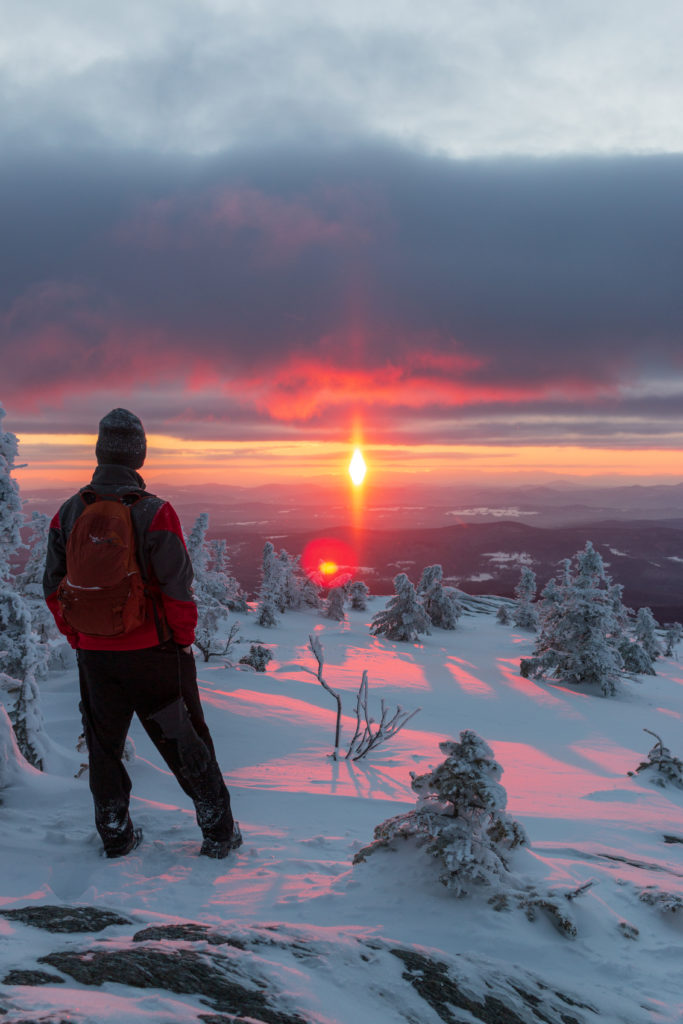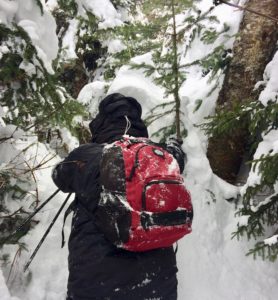This article was written by Neil van Dyke and previously appeared in the Winter 2020 Long Trail News under the headline “Winter Hiking Safety.”
 There are few times more beautiful for hiking than a crisp, clear Green Mountain winter day. The deep blue of the sky is experienced at no other time of year, and when coupled with trees blanketed in fresh snow it presents a truly unique landscape. The lack of crowds adds allure and a sense of solitude.
There are few times more beautiful for hiking than a crisp, clear Green Mountain winter day. The deep blue of the sky is experienced at no other time of year, and when coupled with trees blanketed in fresh snow it presents a truly unique landscape. The lack of crowds adds allure and a sense of solitude.
But backcountry winter hiking also has risks and challenges for which you must prepare. You should always take the ten essentials, but below are more things to be aware of:
Clothing and Gear
The right clothing and equipment is essential. Moisture is your enemy, so dress in layers that can be adjusted as exertion and weather vary. Start with a good wool or synthetic base layer against your skin, followed by insulating layers. Finish with a waterproof, windproof and breathable outer shell layer to protect you from wind, snow or rain. Always take one more insulating layer than you think you will need, and leave cotton clothing at home!
Insulated winter boots are a must. You will likely need several kinds of traction devices for your boots. Snowshoes are best to assist with deep snow, while Microspikes or crampons are necessary to prevent falling on ice. Bare ground at the trailhead doesn’t mean you won’t find snow or ice farther on.
Most people find ski poles a big help, since trekking poles without baskets sink through the snow. Consider taking some type of lightweight emergency shelter (tarp, bivy sack, sleeping bag) for the group.
Weather

Always check the weather forecast before you go, and be flexible. If intense cold or high winds are predicted, scale back your plans. Rain can be the most dangerous weather, because a rapid drop in temperature and a brisk wind often follow — a recipe for hypothermia. As mentioned in the clothing tips, your goal is to stay dry at all costs. If you get wet, turn around!
Remember days are much shorter than in summer, so start early, and plan to be out of the woods well before dark. Hiking in winter is slower and often much more arduous than in other seasons, so allow plenty of time. Take a flashlight or headlamp with fresh batteries. Better yet, take two.
Route finding
The Long Trail is not maintained for winter use. White blazes are hard to see on snowy tree trunks, and blazes and signs may be buried in snow. Also, the trail corridor is not cleared for walking four to five feet above the ground, so the path may be obscured or blocked by branches.
Thus, many sections of the trail are essentially impossible to follow in midwinter. Unless you are experienced at bushwhacking and backcountry navigation, stick to popular and well-used trails. Take a paper map and compass and know how to use them.
Safety and Emergency Planning
If you lose the trail or get hurt in summer it’s certainly a bummer, but typically not life threatening. But in winter even a minor mishap can become a truly life-or-death situation. The leading cause of death for hikers in Vermont is hypothermia. Hypothermia can set in as you wait for help, so you must be prepared to keep warm.
More Safety Precautions
- Don’t hike alone! If something goes wrong, you may need to send for assistance. Most experts recommend a party size of four (three minimum), so one person can stay with an injured party and others can go for help.
- Tell somebody where you are going and when you plan to return. Give them a worst-case estimate so they’ll know when to call the authorities (911) if they haven’t heard from you. Be sure to notify them promptly once you have finished your hike!
- Do not rely on cell phones for anything other than communication. Cold weather severely reduces battery life, so if you need to call for help you’ll be glad you conserved your phone’s battery instead of using it as a flashlight or map. Make sure to fully charge your phone in advance. While you hike, leave it on airplane mode, and carry it in a pocket next to your body to keep it warm. Remember though, much of the backcountry in Vermont has little to no cell coverage, so a charged cell phone is no substitute for good equipment!
- Have enough extra supplies to survive until help can arrive – which may be many hours. Even if you can call 911 immediately, rescue groups will take time to assemble, hike in, and help you.
 If you’re new to winter hiking, it’s a good idea to attend a workshop or go with more experienced folks so you can gradually learn skills and build confidence for more challenging hikes. Check out GMC’s recent Intro to Winter Hiking webinar and check here for upcoming outings and workshops.
If you’re new to winter hiking, it’s a good idea to attend a workshop or go with more experienced folks so you can gradually learn skills and build confidence for more challenging hikes. Check out GMC’s recent Intro to Winter Hiking webinar and check here for upcoming outings and workshops.
By taking the above precautions you will be well on your way to enjoying hiking in Vermont in all four seasons!
Neil Van Dyke is the Search and Rescue Coordinator for the Vermont Department of Public Safety, and he has participated in and coordinated countless backcountry searches and hiker rescues. An avid hiker and long time GMC member, he provides search and rescue training each spring to the club’s field staff.
Read more on winter hiking from GMC:




















[…] more tips for safe winter hiking from a Vermont Search and Rescue Coordinator. He’s one of the team that would be called to rescue […]